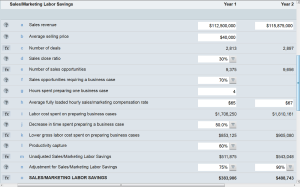
If you want to influence your prospects and customers, your best bet is to create a business case to show how they can reap value from your offering. However, if the business case includes labor savings as one of the value drivers, you will often get push back from your prospect. It’s sometimes difficult to get buy-in for a number of reasons:
- Labor savings are often spread out among many employees and, therefore, receive the label of “soft benefits” that delivers no real economic value.
- Companies can only realize these savings by taking some action (e.g., reducing headcount, not hiring more employees, or reassigning employees to other duties) that requires them to overcome the status quo.
- Sometimes the savings you’re proposing might create special hurdles internally for the prospective buyer (e.g., selling a solution that reduces IT headcount to an IT department can be tough).
- Companies have been promised productivity gains before, but rarely have seen the results (usually due to not taking the required action described above or lack of measurement).
These factors don’t have to stand in your way, however. The approach I advocate enables you to have a productive discussion with buyers around labor savings and build a defensible business case. Here’s how I suggest you proceed:
1. Don’t use a broad brush.
Don't say something like, “We can cut ten percent of your workforce.” Rather, be specific and appropriately categorize the labor savings by role or work process. It’s better to say, “Our solution can save you three full time equivalents (FTEs) in your billing department.”
2. Make sure that the buyer understands the size of his or her problem.
S/he should know how much is the issue costing the company before you show the anticipated savings.
3. Don’t force projected savings on your prospect.
If possible, use an industry benchmark or case study as a starting point. More important, spend time communicating with your prospect until the two of you agree on an achievable savings. Taking the time to commit to this deeper level of engagement can help you establish credibility.
4. Use what we at Stratavant call a “productivity capture factor.”
This factor is a percentage with a value between 0 and 100 percent. It is used to provide a conservative estimate of the projected labor savings. Here’s an example. If the total projected savings are $500,000 and the productivity capture factor is 80 percent, the “new” savings becomes $400,000.
This adjustment acknowledges that even if one hour of time is saved, it doesn’t mean that the one hour will be used to reduce payroll costs, avoid hiring another person for an hour, or be spent on some other value-added activity. In actuality, some of that one hour saved may be used by the employee to surf the internet or engage in water cooler talk.
The productivity capture factor helps you proactively address that reality. When having this discussion with your prospect, keep these quick tips in mind:
- A lower factor should be used when the savings are made up of a little bit of time saved per worker spread across a large number of workers. Though saving five minutes a day per employee across 1,000 employees may add up to a large savings, it’s hard for an organization to realize that entire savings.
- A higher factor can be used if the savings come from hourly or contract workers as it’s easier for an organization to achieve those savings.
- A higher factor can also be used when the savings are concentrated in one role or job class.
5. Implement a ramp rate factor if your business case contains more than one year’s worth of savings.
The ramp rate lets you tell your buyer that labor savings don’t happen overnight. Companies need time to orchestrate employee separations or retrain employees, so it’s better for you to tell your prospect that these savings take time to come to fruition than make a promise that’s unrealistic.
The Five Steps at Work
Below is an example of these five steps at work. The labor savings benefit is quite focused (i.e., sales/marketing labor spent preparing cases). The size of the problem is shown in row [i]. Row [j] illustrates how much the solution in question can reduce the size of the problem. Row [l] is the productivity capture and row [n] is the ramp rate.
By adopting these five steps, you will have a credible way to include labor savings in a business case. And with these savings, your offering delivers a more compelling value proposition to buyers.
Have you ever tried any or all of these steps? Share your comments below.









